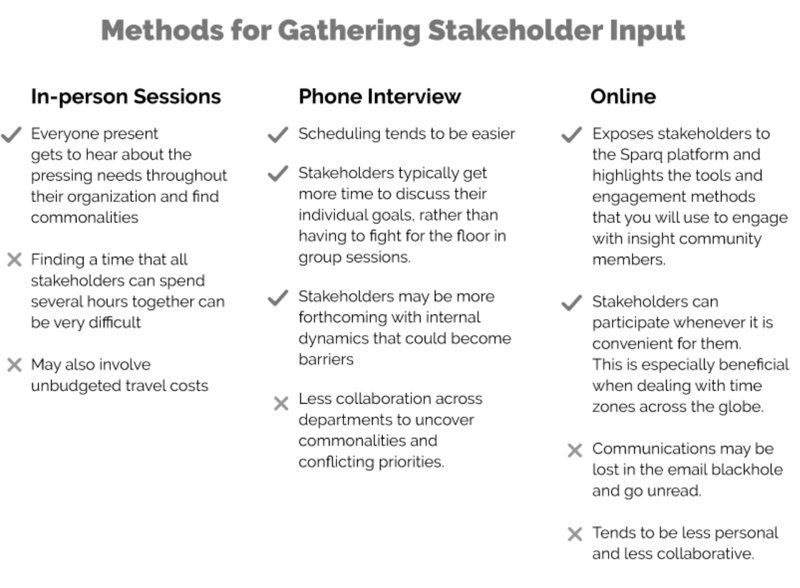An insight roadmap is a plan to keep your organization focused on customer centricity. It brings together stakeholders to agree on key objectives that your insight community will inform. It will help operationalize your community and give the insight community manager a path forward to inform the business. We’ve seen this approach helpful when starting a new insight community, and as an annual exercise for well-established insight functions.
In this post, we’ll discuss why you might need it, offer some considerations, and offer recommended logistics. We’ll share what we learned doing it in our own organizations and our customers’ experience.
- 90% of insight community managers on Alida's community use some form of calendar to plan activities. Three-quarters of them plan for at least one month out.
- 62% say their calendar is constantly in flux and another 24% say it's prone to some change.
Reasons and Benefits for Having an Insight Community
Find Common Ground in an Endless Sea of Needs
Some organizations have so many ideas and information needs that it is hard to know where to start. It’s an overwhelming task for the insight community manager to make sense of this. A guided process helps stakeholders and insight community managers understand how needs fit into the broader picture. Often the common themes emerge, which can be consolidated into projects.
Build Empathy to Establish Priority
Seeing the breadth of needs across the organization may help stakeholders be more patient waiting for their project to come up in the queue. Or, it leads to open discussions, or maybe bargaining/bribing/arm wrestling internally to determine who gets priority in the roadmap. We provide more guidance on prioritizing below.
Manage Member Experience with a Schedule
Some organizations struggle to pace out the activities conducted on their insight community. The result can be too many activities that overburden members, and/or long lags between activities where members lose interest. Neither of these scenarios are good for long-term insight community health. Having a roadmap helps avoid these issues.
“I am very concerned with over-burdening the community members. It can be difficult to meet internal expectations and community health at the same time.” — Sr Consumer Research Manager, B2B technology industry
Guarantee a Path for Return on Your Investment
Finally, having an insights roadmap ensures strong ROI on your insight community investment. It’s easier to demonstrate value when stakeholders across your organization have participated and understand how the business has been informed.
Logistics of Gathering Input from Stakeholders
We’ve gathered input in three primary ways. Use the pros and cons of each to help you decide which may be best for your organization.

Give Homework to Your Stakeholders
To ensure productive sessions when gathering input, ask your stakeholders to do simple homework. The homework is not burdensome yet it ensures stakeholders have focused time thinking about their goals and are ready for the discussions.
Consider a few short questions like these:
- What are the big questions your organization needs answered by customers?
- Are there other sources of information (think one piece of data) within the organization that could be leveraged to gain deeper insight into community activities?
- What recent trends have emerged that you are concerned about?
- What information about customers would have the greatest value to your team or various departments?
- What are some of the programs, promotions, and/or initiatives that members of the community could co-create with you?
- If we were to meet one year from now, how would you judge the work done on the community as a success?
- If you could ask the community one question, what would it be?
How to Prioritize Stakeholders Needs
You’ve generated many project ideas, but how do you prioritize these?
Not gonna lie. It’s hard. But here are some tips we can offer you:
- Ask for key milestones from stakeholders during your discussions
- For stakeholders who have multiple needs, ask them to prioritize them for you
“In our industry, changes occur frequently. Having to manage panel research for the entire enterprise usually involves many stakeholders, multiple reviews, and last minute changes.” — Customer Experience Manager, Healthcare industry
These will help you understand when the information is most crucial to them, but likely won’t solve all the prioritization problems. You can also try:
- Grouping similar or complementary needs together
- Giving priority to the information needs required by the most people within the organization
- Or, let’s be real, the C suites’ needs likely will trump everyone else in the mix. So, start with those needs first and then see how you can fill in the rest.
- If all else fails, accept bribes ;-)
At Alida, we asked stakeholders to focus on projects that would most impact their corporate KPIs.
Synthesizing and Compiling Ideas into a Calendar
When plotting out the activities you need to consider cadence and insight community size, along with whom you’d like to target with each activity.
- Cadence: In general, to ensure community health, it is recommended to engage each community member with about one to three activities per month. If you have a business-to-business community, you’ll likely want to stay on the low end of that range, but if you have a super engaged community, like video gamers, you may be able to push beyond the upper limit of the range.
- Community size: If you have a large community, with members numbering in the thousands, you will have the benefit of being able to conduct multiple activities at the same time by sending each activity to only a subgroup of the community.
- Targeting of activities: Some of the activities you want to conduct may not need input from all community members. For example, perhaps you’ve fine-tuned a product feature based on results from a previous survey and you’d now like to get user feedback again. You will want to target this activity to community members who told you they use that feature, which could just be a handful of members. While you are conducting a discussion forum with that small niche group, you could also conduct a survey on another topic with a larger group.
Balance Stakeholder Needs and Customer Experience
When planning activities for your insight community, include activities that are focused on the members’ needs or are even just for fun. If you’ve been doing marketing research for a while, this can sometimes be difficult, as you’ve likely not had to think about engagement activities with respondents before.
Share Responsibility for Engagement
Stakeholders who are benefiting from insights generated by the insight community also bear responsibility to help with engagement and shareback activities.
For our Alida community, Alida Sparq Next, it is a requirement that stakeholders who request and receive insights provide a shareback on our member hub and elaborate on detail in our stakeholder hub. They are also encouraged to provide video introductions for surveys outlining the reasons why they are asking for the insight.
What to Do Next?
Share the plan with stakeholders so they know what to expect. You can do this either via a follow-up meeting or via email. At Alida, we use our internal stakeholder hub and a shared calendar. Over half of our insight community members use Excel to manage a calendar.
Remember the plan is fluid. Give yourself permission to divert when necessary. Priorities change and urgent needs arise. Flex and adjust as needed.
Reassess often, regroup and shareback with stakeholders. For our internal Alida community, monthly update meetings are held (and recorded) so stakeholders are aware of progress and adjustments made.
Store overflow ideas in a parking lot to slot in when other activities slip. Inform stakeholders that even if an activity they’d like to conduct doesn’t have a slot in the calendar currently, providing the information necessary to design the activity ahead of time will help it get bumped up in the queue.
“Clients still have ad hoc requests that can be difficult to fit into the calendar. Whenever that happens, we have to prioritize and ultimately someone will have to wait.” — Research and Insight Lead, Financial Service industry.







